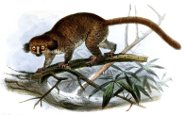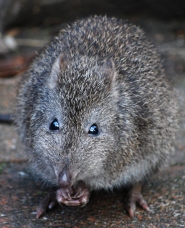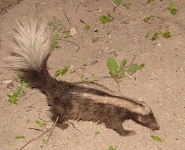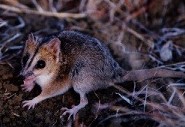Monday 19 January 2015
Hairy-eared dwarf lemur

The
Hairy-eared Dwarf Lemur (Allocebus trichotis) is a nocturnal primate, the only member of the genus Allocebus of the family Cheirogaleidae. This species is endemic to
Madagascar. Hairy-eared Dwarf lemur has been found at the nature reserves of Mananara, Zahamena, and Vohidrazana in Madagascar. This species lives originally in the primary lowland rainforests.
The hairy-eared dwarf lemur is one of the smallest primates with a weight of only 80 to 100 g (3 -3.6 oz) and a length of 30 cm. It has a galago-like ear. This could mean that it is, together with other cheirogalieds, more closely related to the galagos and lorises than to the lemurs. This species has a relatively longer tongue than the Microcebus and Cheirogaleus specie. The overall pelage color for Hairy-eared Dwarf lemur is gray. It has a brown tail and a face with a white stripe running from the rostrum or nose to between the eyes as well as dark rings surrounding its eyes. Its ears have tufts of brown while its teeth structure and claws are sharp.
It was observed in captivity that males and females tend to groom each other by removing dead skin and parasites before leaving their nest at night. The hairy-eared dwarf lemur leaps frequently among branches of trees, they have been observed to leap more often than members of the genera Cheirogaleus and Microcebus. Although they typically forage and feed alone at night, these lemurs live in social networks with overlapping ranges, and they have occasional contacts mainly based on vocalizations and scent marking during the night. Due to small body size, most vocalizations are relatively high-pitched small-contact, alarm, threat, and range defense.
Interestingly, the hairy-eared dwarf lemur is one of the world's rarest mammals. This species was assumed to be extinct because no specimen had been seen from 1875 until 1966. It was rediscovered in 1966 on the east coast of Madagascar near Mananara. In 1989, two live members were found in the same vicinity, south of the Mananara River. As of 1997, it was still known only from eastern Madagascar near Mananara. The status has been changed from Critically Endangered to Endangered in 1996 due to the discovery of new subpopulations.
The hairy-eared dwarf lemur is trapped and eaten by local inhabitants. Deforestation of its habitat for agriculture and logging is also another reason why it has decreased in population.
You can help spreading the word about this animal by liking it on facebook
Permanent Link
Monday 12 January 2015
Long-nosed Potoroo -- Marsupial Tiller of the Soil

The long-nosed potoroo (
Potorous tridactylus) is a small marsupial that performs a big job for the Australian environment. This small, peculiar-looking marsupial constantly digs at the ground looking for food. In this way, it acts as an earthworm to help till the soil.
Australia does not have any earthworms but does have termites and the long-nosed potoroo, which is a lot more physically attractive than a termite.
There are four different species of potoroo in Australia. The name is similar to “kangaroo” and the two types of “roos” share many similarities. They both grow their babies or joeys in pouches rather than in a womb. They both hop. But unlike the kangaroo species, potoroos are all in danger of extinction because of habitat loss and falling prey for cats and foxes. These formidable predators were introduced to Australia with the first European colonists. Long-nosed potoroos need areas of thick undergrowth to grow the food they need. These areas are rapidly disappearing.
Physical Description
The long-nosed potoroo looks like a cross between an elephant shrew and a kangaroo. It has wide forehead that tapers to a long, pointed nose. The tip of the nose is hairless and pink. The body is covered in short fur colored in shades of brown and gray. The forelegs are much shorter than the hind legs but are muscular enough for digging. The long, slim tail is mostly furred. Males and females are hard to tell apart.
Males and females grow to a similar size and weight. Adults weigh up to 2.86 pounds (1.3 kilograms.) From nose to rump, adult long-nosed potoroos grow to a length of 14.17 inches (36 centimeters.) This is about as large as a rabbit. The long tail can grow up to 9.05 inches (23 centimeters.) Long-nosed potoroos can use the tail to help balance when they sit up to use their forelegs for eating, digging or hopping.
Life Cycle and Behavior
Long-nosed potoroos are mostly active at night, although sometimes they come out from their burrows during the day. They prefer to move under cover of long grasses or plants. They create escape routes to underground burrows in these grasses, meticulously removing any debris from these paths that may trip them up as they race away from predators. They feed mostly on fungus, but also on bulbs, roots, seeds and occasionally insects.
Males become sexually mature when they about 11 months old. Females need to be between one and 2 years old. They breed year round. After a 38 day gestation, the female gives birth to one or two embryos, which crawl into her pouch, find a teat and remain there for the next four months. Mom turns them out of the pouch when they are 6 months old. In captivity, long-nosed potoroos live up to 7 years.
Picture of the long-nosed potoroo by Peripitus, licensed under GFDL and the
Creative Commons Attribution-Share Alike 3.0 Unported
You can help spreading the word about this animal by liking it on facebook
Permanent Link
Saturday 10 January 2015
Striped Hog-Nosed Skunk - A Little Loner

The
Striped Hog-Nosed Skunk (
Conepatus Semistriatus), also referred to as the Amazonian Hog-Nosed Skunk, is a Neotropical mammal. This means that they are generally found in Central and South America, from Southern Mexico continuing South Eastwards into Peru and Eastern Brazil. The Striped Hog-Nosed Skunk is similar in size to an average domestic house cat, perhaps slightly smaller. Their size is about 57 cm (22 inches) in length with an average weight of 1.6 kg (3.5 lbs), and the male of the species is generally larger than the female.
In appearance, the Striped Hog-Nosed Skunk is similar to the common skunk found in North America with some slight differences. Their coat is predominately black in color with the white stripe forming at the back of their necks and extending down their back where it divides into two stripes. The tail is black and white but not as bushy as that of other species and their coat is very coarse, lacking the qualities for which the North American skunk is valued. The nose is long and extends into a pig-like "snout" which is used to root in the Earth, and the front feet have strong sharp claws for digging. Like all skunks, they have anal glands which are capable of spraying a foul-smelling musk when threatened.
The habitat of the Striped Hog-Nosed Skunk changes seasonally. During dry seasons they can be predominately found in deciduous forests, shrub woodlands, and occasionally grasslands. They tend to avoid desert areas and thickly wooded forests, preferring more sparsely wooded areas. During the wet season, the skunks tend to be more selective, sticking to higher levels of elevation where food is plentiful. The omnivorous creatures feed on insects, fruit and eggs, invertebrates, and small vertebrates such as lizards and small mammals.
The Striped Hog-Nosed Skunk is quite the solitary little mammal. Being both loners and nocturnal, their mating habits and reproduction cycles are not widely documented. It is assumed that these are similar to that of other skunk species, which means that mating generally occurs in the spring and results in one litter of 2-5 offspring per year. They most likely retreat underground or into some type of den or burrow to give birth. The lifespan of this animal is not known for longevity, and at this time the Striped Hog-Nosed Skunk does not appear on any endangered species or conservation lists.
Picture of the Striped hog-nosed skunk by Washington L. S. Vieira, licensed under
Creative Commons Attribution 2.0 Generic license.
You can help spreading the word about this animal by liking it on facebook
Permanent Link
Thursday 08 January 2015
Julia Creek Dunnart - Mouse-like Marsupial

The Julia Creek dunnart (Sminthopsis douglasi) shares two features with the vastly different kangaroo – both are marsupials. Instead of developing in a womb, the babies develop in a pouch. Both creatures live in Australia. Unlike the kangaroo, the Julia Creek dunnart is considered endangered under Australian law. Its habitat has been restricted to a small Northeastern portion of Australia called the Mitchell Grass Downs, where a Julia Creek resides. This is an arid environment.
The Julia Creek dunnart was almost wiped out before it was discovered in the 1930. The species was thought to have been wiped out by invasive species such as the
European fox and the domestic cat until it was rediscovered in 1992. Populations have risen slightly since then as
Australia has begun exterminating stray cats. The Julia Creek dunnart is still prey for dingos.
General Description
This little marsupial strongly resembles a mouse, with tiny pink paws and a long, naked tail. Its coat is a light sandy brown with a dark stripe running from the tip of the nose down the spine. The dark eyes are large in comparison to the rest of the head. The belly, chest and inside of the legs are white.
Adults weigh in between 1.41 to 2.47 ounces (40 to 70 grams) and reach a nose to tail length of 6.3 to 9.45 inches (160 to 240 millimeters.) The tail is almost as long as the rest of the body. The Julia Creek dunnart is the largest of the 21 known species of dunnarts or mouse-like narrow-footed marsupials.
Life Cycle and Behavior
After a gestation of a mere 12 days, the females expel the pink embryos, which crawl from the vagina to the pouch. The embryos are so undeveloped that they do not have lungs and absorb oxygen through their skin. A female can have up to eight babies or joeys at a time. Julia Creek dunnarts begin hunting when they are only 10 weeks old. Julia Creek dunnarts live in family colonies and enjoy each other’s company.
Julia Creek dunnarts can take down lizards and mice nearly twice their size. They also hunt spiders and insects. They rarely need to drink because their prey contains the moisture they need. They make their homes deep in crevices in the ground during the day and come up at night to hunt. They can go into a hibernation-like state in order to survive times of famine.
Picture of the Julia Creek Dunnart by ZooPro, licensed under the
Creative Commons Attribution-Share Alike 3.0 Unported license.
You can help spreading the word about this animal by liking it on facebook
Permanent Link
 The Hairy-eared Dwarf Lemur (Allocebus trichotis) is a nocturnal primate, the only member of the genus Allocebus of the family Cheirogaleidae. This species is endemic to Madagascar. Hairy-eared Dwarf lemur has been found at the nature reserves of Mananara, Zahamena, and Vohidrazana in Madagascar. This species lives originally in the primary lowland rainforests.
The Hairy-eared Dwarf Lemur (Allocebus trichotis) is a nocturnal primate, the only member of the genus Allocebus of the family Cheirogaleidae. This species is endemic to Madagascar. Hairy-eared Dwarf lemur has been found at the nature reserves of Mananara, Zahamena, and Vohidrazana in Madagascar. This species lives originally in the primary lowland rainforests. 
 The long-nosed potoroo (Potorous tridactylus) is a small marsupial that performs a big job for the Australian environment. This small, peculiar-looking marsupial constantly digs at the ground looking for food. In this way, it acts as an earthworm to help till the soil.
The long-nosed potoroo (Potorous tridactylus) is a small marsupial that performs a big job for the Australian environment. This small, peculiar-looking marsupial constantly digs at the ground looking for food. In this way, it acts as an earthworm to help till the soil.  The
The  The Julia Creek dunnart (Sminthopsis douglasi) shares two features with the vastly different kangaroo – both are marsupials. Instead of developing in a womb, the babies develop in a pouch. Both creatures live in Australia. Unlike the kangaroo, the Julia Creek dunnart is considered endangered under Australian law. Its habitat has been restricted to a small Northeastern portion of Australia called the Mitchell Grass Downs, where a Julia Creek resides. This is an arid environment.
The Julia Creek dunnart (Sminthopsis douglasi) shares two features with the vastly different kangaroo – both are marsupials. Instead of developing in a womb, the babies develop in a pouch. Both creatures live in Australia. Unlike the kangaroo, the Julia Creek dunnart is considered endangered under Australian law. Its habitat has been restricted to a small Northeastern portion of Australia called the Mitchell Grass Downs, where a Julia Creek resides. This is an arid environment.